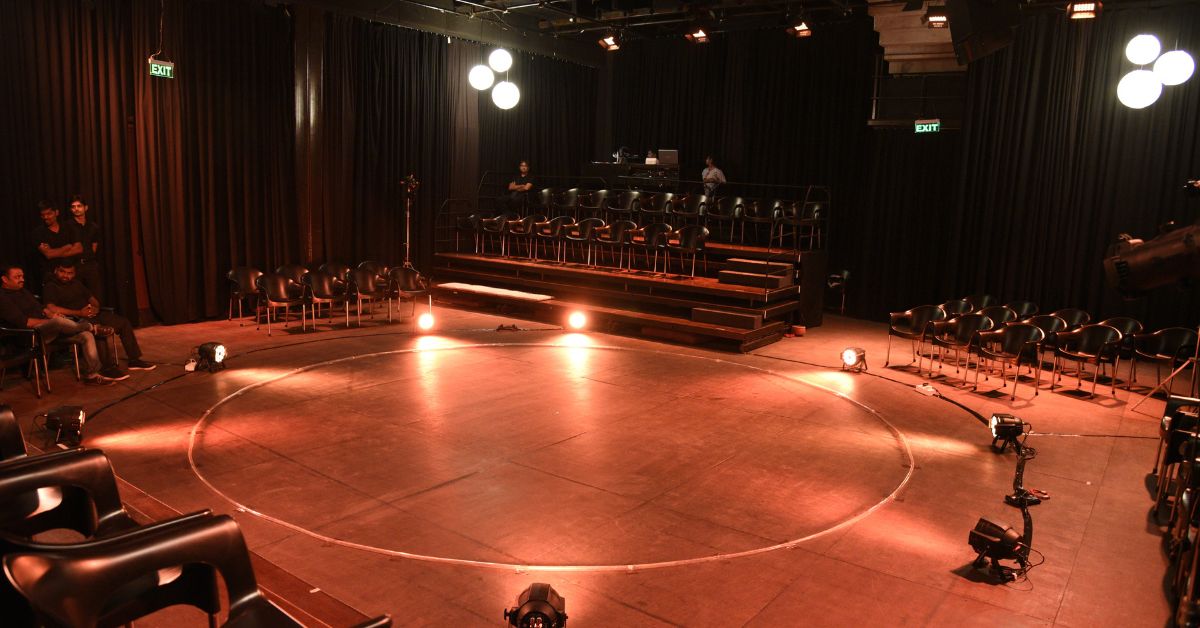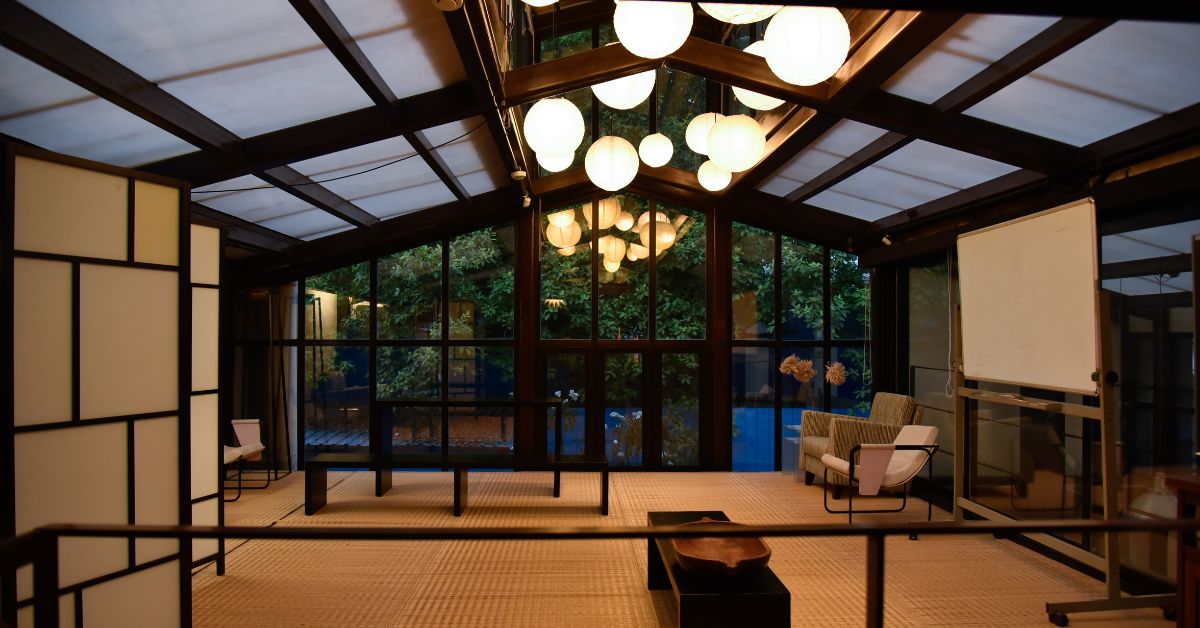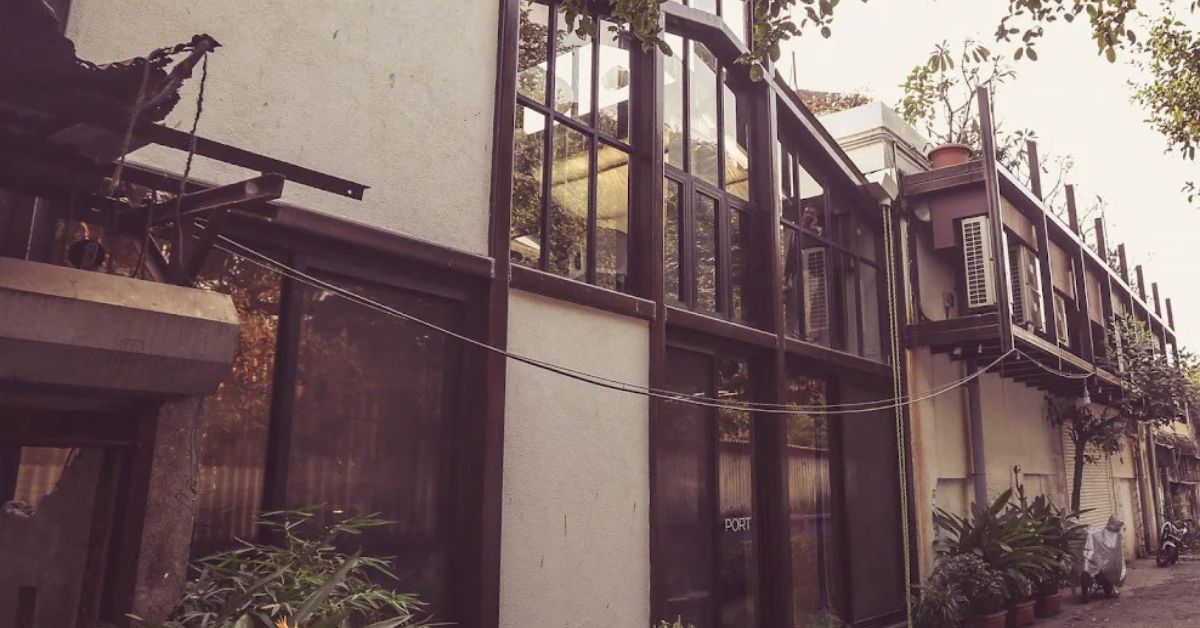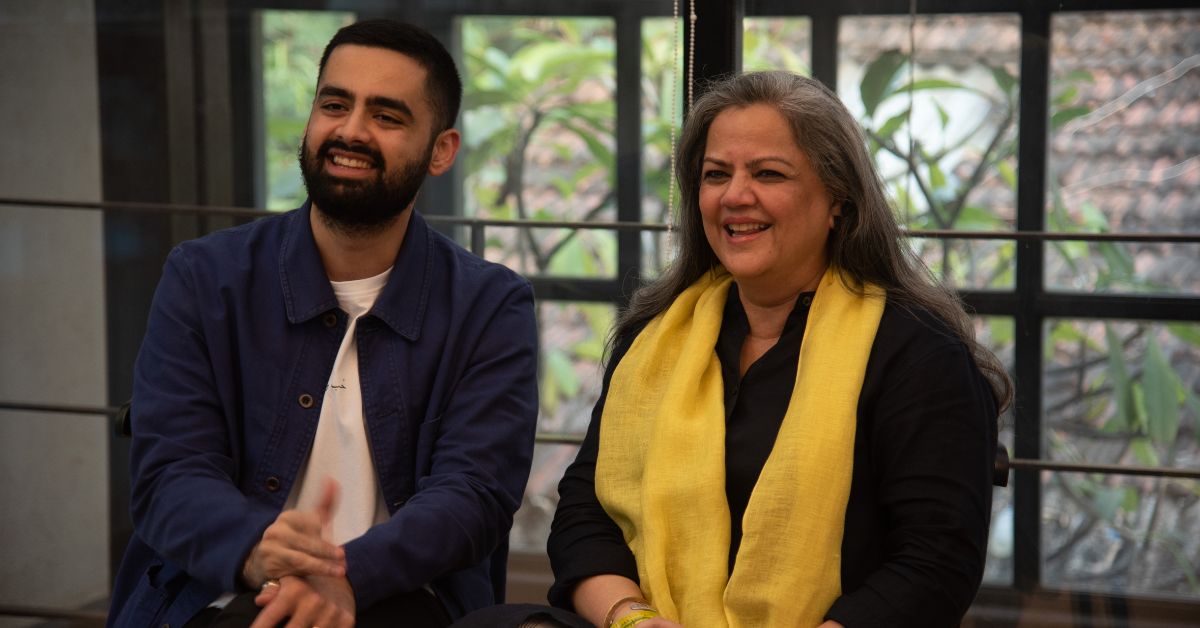How an Architect Turned a Dusty Abandoned Mumbai Warehouse Into a Home for the Arts
It’s a warm afternoon in Mumbai; the city’s mercury levels are setting new benchmarks every day. But even as Mumbai sweats, a certain room in the city’s Shakti Mills neighbourhood appears to be immune, both to the heat and the cosmopolitanism brewing outside its perimeters. The ‘Black Box’ — the first of its kind in India — (the room’s aesthetic mimics its moniker) is an architecturally striking oasis of cool.
But if the room could speak, it would argue that, ever so often, it’s flooded with warmth in the form of conversations that are born here. You see, the Black Box nestled in G5A — the city’s very own album of contemporary art, is a multi-functional space that plays host to screenings, performances and plays.
Mumbai-based architect and filmmaker Anuradha Parikh charts the course of transforming a once humble warehouse in Mumbai’s Shakti Mills into its current identity as a ‘home for experimental and independent arts’. At the end of the process, the space wasn’t the only thing that had metamorphosed. Parikh had, too.
 The Black Box is a unique, multifunctional space that presents screenings, conversations, performances, presentations, workshops, and courses
The Black Box is a unique, multifunctional space that presents screenings, conversations, performances, presentations, workshops, and courses
Today, G5A stands against the cityline as a pièce de résistance for the contemporary arts, daring urbanity to challenge its ideals. Through its repertoire of screenings, conversations and theatre festivals, it is furthering the legacy of the artistic movement that enveloped Mumbai in a tight embrace from the 1960s through the 1980s. To Parikh, the Black Box is a metaphor for potential, for infinite possibility. “In a black void, you don’t see any specific form, you don’t see boundaries.”
She recalls the conundrum of finding a middle ground between wanting to redesign completely and wanting to preserve the antiquity of the warehouse. Finally, her design philosophy leaned towards the latter. But the premise was always inclusion. “I did not want this to become just a venue, but instead, a space that would be accessible for local communities. Our tagline ‘culture, community, and city’ gives an essence of what G5A was meant to be,” she shares.
Where art and community convene
Reserved for VIPs
The words are sometimes plastered on the front-row seats at programmes at G5A. Guests filing in leave the seats vacant, which soon seat their lawful occupants — the millworkers, the Kolis, members of the Worli Koliwada sea-faring community, and others in the neighbourhood.
At these programmes, they are the “missing VIPs”, Parikh points out. This thought aligns with her intent of making the local communities important stakeholders of the G5A mission. “Art enables us to think differently, shifts something in us,” she emphasises. “It empowers us to redefine how we live our lives, how we vote (from Leonard Bernstein’s quote that is mounted on one of their walls), and gives us a kit for life.”
Parikh’s familiarity with contemporary art disciplines borrows from her parents. Her mother, Shaila Mohile Parikh, founded the famed Mohile Parikh Centre — an internationally renowned institution devoted to art and culture — at the NCPA (National Centre for the Performing Arts) in Mumbai, while her father, Jagdish Parikh, was chairperson of the Film Finance Corporation (“which he redefined as the National Film Development Corporation”).
Parikh’s childhood and youth were filled with encounters with the likes of Shyam Benegal (also known as the pioneer of parallel Indian cinema) Mani Kaul, Kumar Shahani, renowned artists M F Husain, Akbar Padamsee, Nalini Malani, Raza, famed classical musicians Vilayat Khan, Bhimsain Joshi, Shobha Gurtu, and visionary architects Charles Correa and B V Doshi. “I was privileged to grow up in that environment, with all of these artists as a kind of extended family,” Parikh points out.
A deep respect for art was part of the family’s lingua franca.
 G5A was repurposed from a space that served as a warehouse for mill workers to now a thriving space for culture and arts
G5A was repurposed from a space that served as a warehouse for mill workers to now a thriving space for culture and arts
This was during the 1970s when the wave of alternative cinema was steadily picking up. The movement’s genius lay in its realism and complex themes. The filmmakers during this time brought style and substance to the rhetoric, allowing societal issues to be viewed from a nuanced lens. But in the decades that followed, this cinematic brilliance was wrestled from the city by commercial mainstream movies.
“Mumbai’s seams began bursting with urban development,” Parikh puts the case into point as she speaks of how this increased the pressure on art and artists. “In the evolution of Bombay, art became a victim. And, in the battle between commerce and art, we gave in to commerce.”
Where Mumbai’s art scene found shelter
Recalling the “despair and urgency” she felt at wanting to revive the city’s imaginative palette once again, before contemporary art became an enigma, Parikh says she needed a space to let her plans unfold. The dots connected and led her to the warehouse, which stood desolate on the piece of land where her father earlier ran his printing press.
“My first thought was to create a space whose doors would be open to everyone. A space that would feel welcoming and like home,” Parikh shares. Her intent was for art – the kind she had grown up respecting and admiring — to find its way once more into the city’s lexicon. And that’s how G5A was born, marking out a space where art gets its dues. Parikh retained the warehouse’s number for its name — G5A as an ode to its legacy. This deeply moved the late Datta Iswalkar (erstwhile union leader of the millworkers) on his last visit to the warehouse.
 Through G5A, Anuradha Parikh wanted to create a space that would be accessible for local communities
Through G5A, Anuradha Parikh wanted to create a space that would be accessible for local communities
The artist roll call on the G5A site is an eclectic mix of talent who explore new landscapes of form and content and push boundaries of comfort and the familiar. A browse through the calendar will reveal a smorgasbord of events, appeasing every kind of creative and courageous palate. With every event, the creative hub promises intrigue.
Watching how the journey of the warehouse unfolded, Parikh is happy. “The good thing is I could see the map in my head,” she makes inferences about the initial days of the restoration. The rendering is rooted in realism, both in the architectural details and the kind of content that the space plays host to.
Parikh pins down the motive of her design philosophy: “I did not want to redesign a new building. So, I let the existing architecture speak to me, taking clues from the warehouse. My goal was to make a contemporary, efficient version of the same.” The current facade of G5A attests to how well she aced the challenge.
 G5A is the city’s very own album of contemporary art, is a multi-functional space that plays host to screenings, performances and plays
G5A is the city’s very own album of contemporary art, is a multi-functional space that plays host to screenings, performances and plays
She muses, “I wanted to be sensitive to the legacy, to the materials, to the movement of sunlight. I maintained the steel vocabulary that existed in the warehouse, but with a totally new vocabulary. When it came to the Black Box, the first of its kind in India, we wanted the sound and picture quality to be on par with international levels.”
Today, the architecture at G5A orchestrates how well functionality and culture can converge. For Parikh, the project wasn’t simply about breathing life into a space that was lost in the mists of time; it was also about giving the city a space that would go beyond a perfunctory role, becoming a dais for important conversations around art and culture in the years to come.
When art becomes a medium for social impact
G5A is more than the sum of its parts.
G5A’s work is spread across multiple disciplines and media. Through the warehouse, the team is constantly refining the work that is produced, curated, and presented to audiences. Their programming properties include, In Residence, which produces and presents new performance projects where practitioners are hosted at the warehouse for an extended duration, Cinema House, a platform for new and independent voices in film from the country and beyond, Live at the Warehouse and That Friday Jazz, that both push the paradigm and scope of independent music and jazz, Baithak that honors and foregrounds the tradition of gathering over intimate Indian classical performances.
 Mumbai-based architect and filmmaker Anuradha Parikh (R) and Ishan Benegal (L) transformed the once humble warehouse in Mumbai’s Shakti Mills into its current identity as a ‘home for experimental and independent arts’
Mumbai-based architect and filmmaker Anuradha Parikh (R) and Ishan Benegal (L) transformed the once humble warehouse in Mumbai’s Shakti Mills into its current identity as a ‘home for experimental and independent arts’
G5A imprint is the literary arts and culture magazine that publishes regular digital volumes consisting of work across text, image, sound, and video. The magazine publishes regular print editions that are an anthology of selected digital works.
G5A cityLAB works to bring change across Mumbai’s communities, bringing artists, creative professionals, government, and other stakeholders to foster culturally vibrant, inclusive, and resilient neighbourhoods, one grassroots effort at a time. The team has undertaken some transformational projects over the years.
Take, for instance, the Swachh Worli Koliwada project, which saw the team bend their heads over a scalable model that would create livelihood opportunities for the Kolis. Launched on 5 June 2018 (World Environment Day), the project envisioned the 65-acre Koliwada area as a self-sustaining zero-waste neighbourhood. “We are all responsible for our waste,” Parikh and team told the community.
“We had proposed collection centres where the waste is segregated and organised, dry waste is recycled, and manure from the wet waste is used for kitchen gardens. We also got the contractors to train and appoint several community members for the project.” The idea was to create a model that would have a sway over the community’s waste disposition ideals. The project involved developing participatory, ground-up processes and systems, along with the community, BMC and experts.
Meanwhile, the Bhendi Bazaar Gharana Project aimed to bridge the cultural chasm in the legacy of Hindustani classical music. Parikh and the team noticed that live performances dedicated to the Bhendi Bazaar Gharana — the only school of Indian classical music (gharana) that emerged in Mumbai in 1890 — are fewer compared to other gharanas (lineage) of Hindustani Classical Music. The reason could be the absence of the sixth generation of disciples. And the gharana was gradually slipping away unnoticed.
G5A cityLAB began ideating about a portal dedicated to the cultural heritage of the Bhendi Bazaar Gharana, where music lovers could access old recordings, archival data on the history of the gharana, and paintings of Anjanibai Malpekar the well known disciple of the gharana, who was also one of the muses of Raja Ravi Varma.
Parikh elaborates on their mentorship programme, which enabled three children from Worli Koliwada who were already learning classical music to engage with some of the practising musicians of the gharana. One of them was then selected to be mentored by Shubha Joshi, one of the disciples of this gharana.
Another project ‘Reclaiming Shakti’ in partnership with Akshara Foundation focused on bolstering the safety measures in the Shakti Mill area following the gruesome gang rape and murder of a photojournalist here in 2013. Sadly, this project did not see the light of day.
In 2024, G5A cityLAB worked in partnership with the D Ward of the BMC to launch the Legacy plaque project (honouring almost 100 cultural, political, and social community members and institutions of Mumbai).
While these are just a sliver of the projects that G5A has championed, there are several more in the works. Through each of its endeavours within the studio and beyond, G5A is adding a bold dynamic to Mumbai’s artistic skyline.
Edited by Vidya Gowri Venkatesh, All pictures courtesy Anuradha Parikh
News